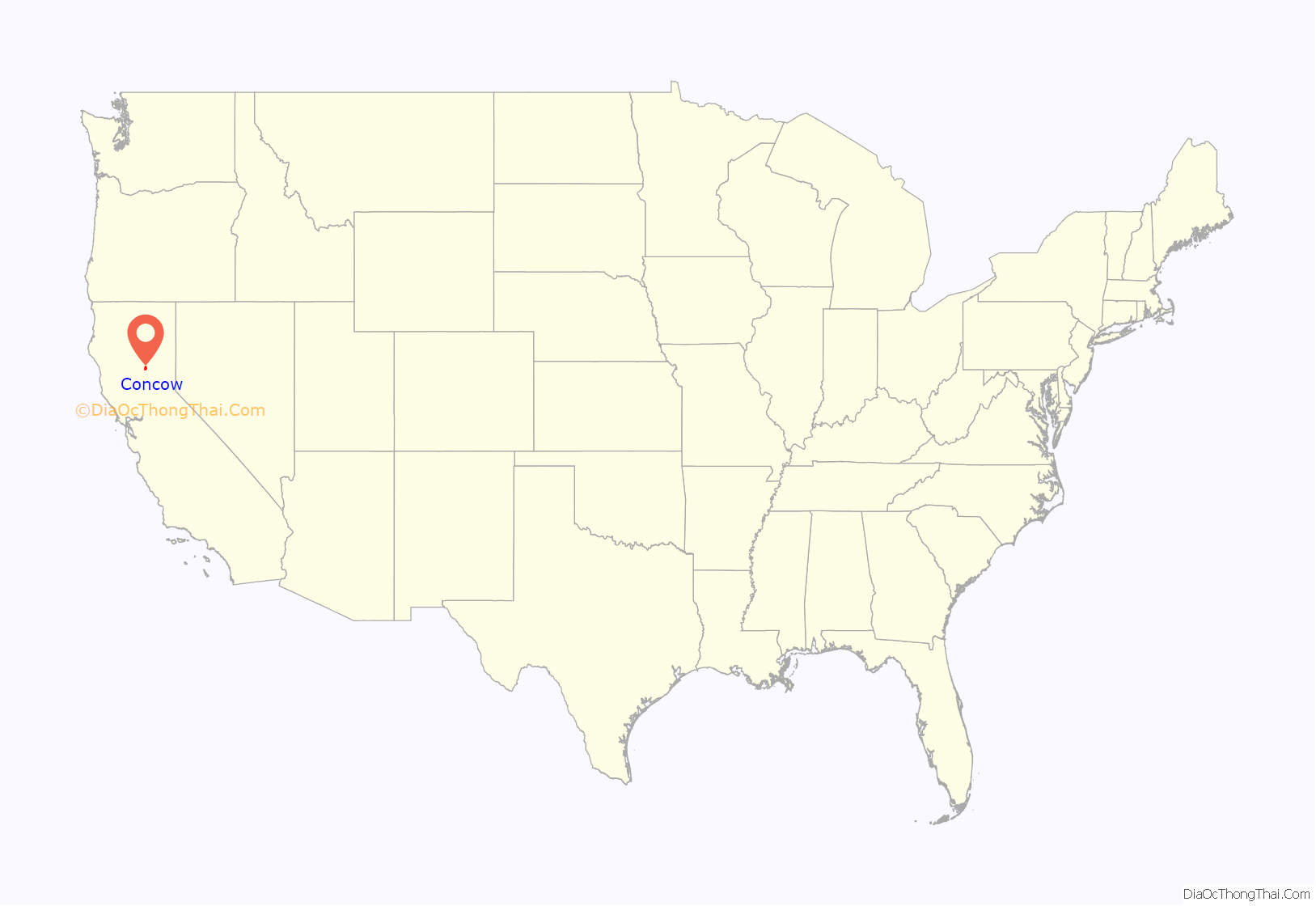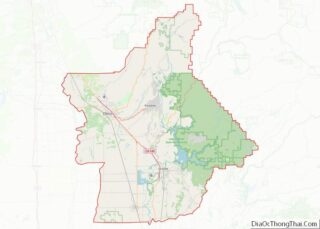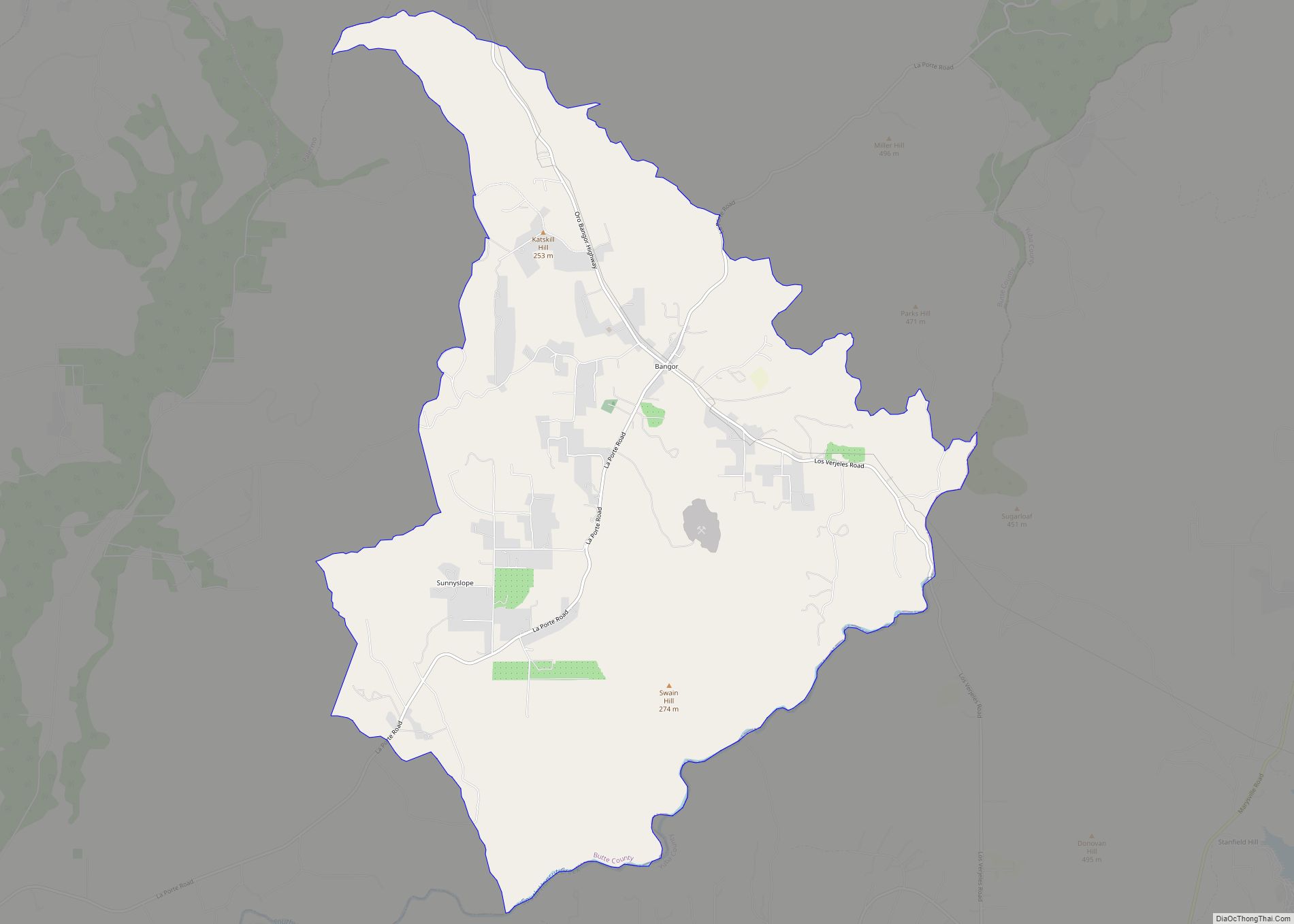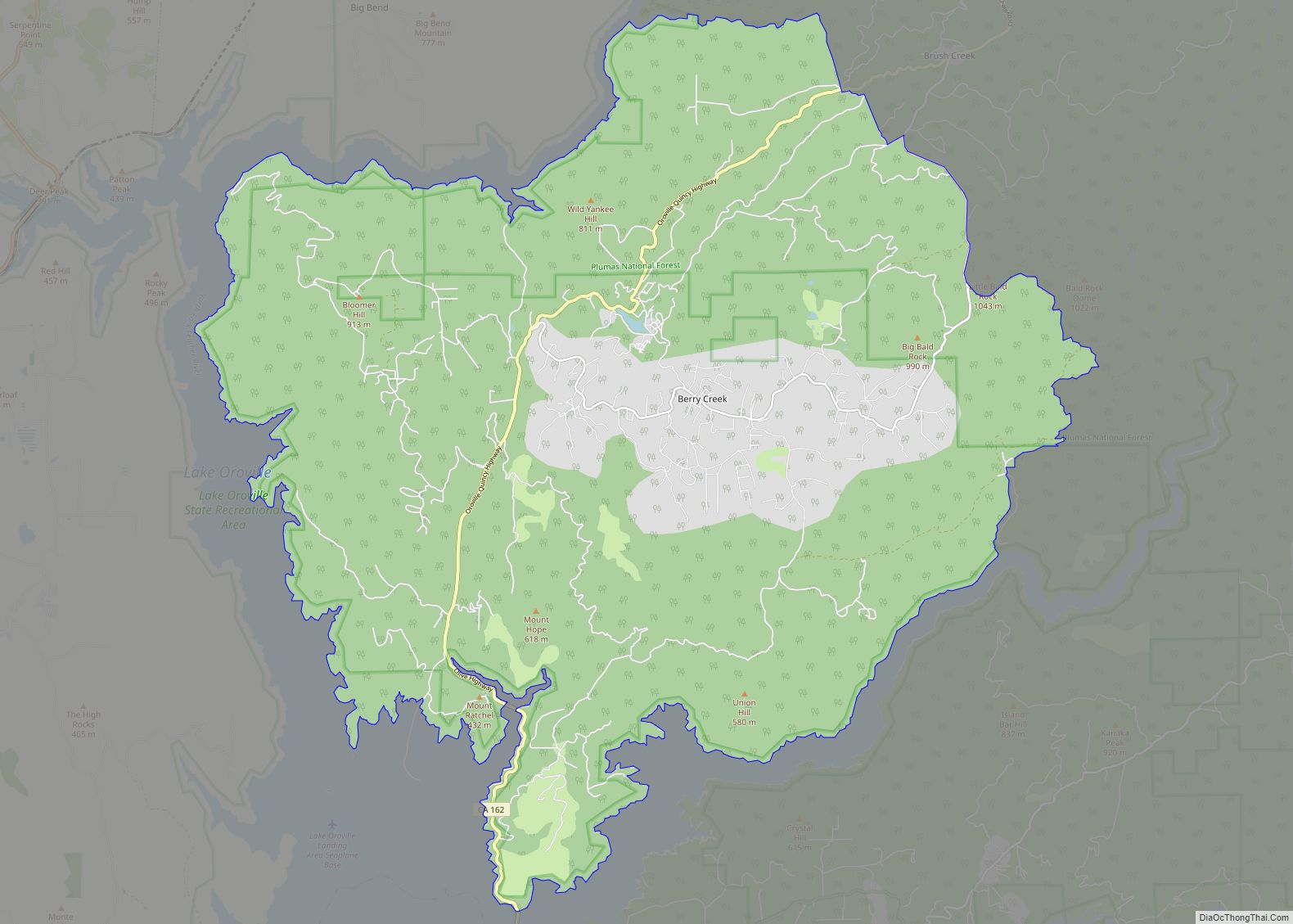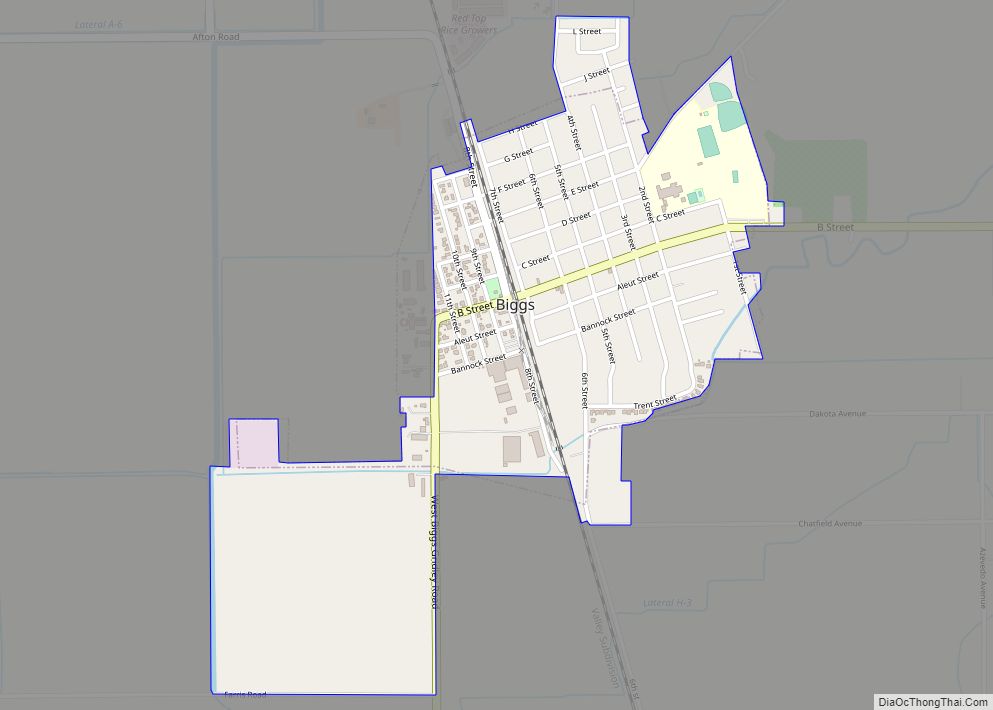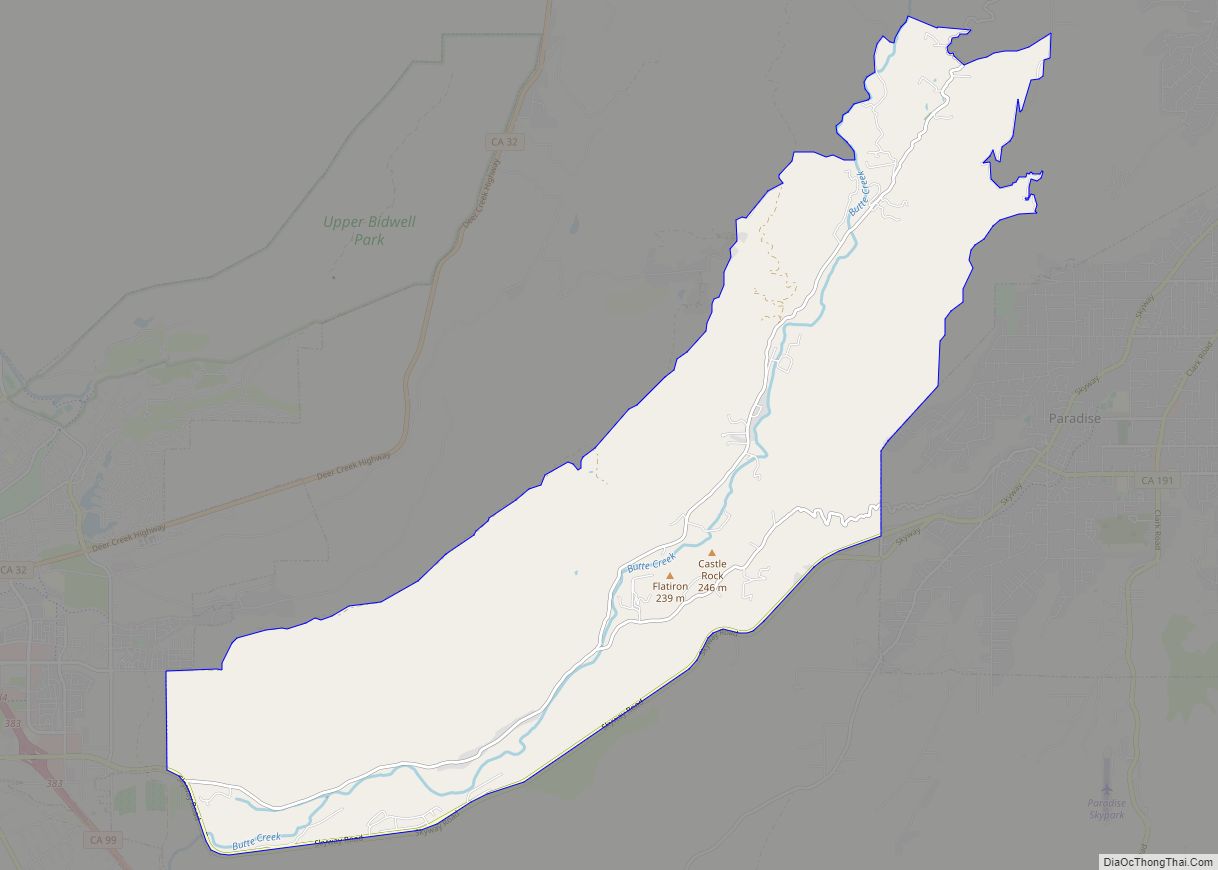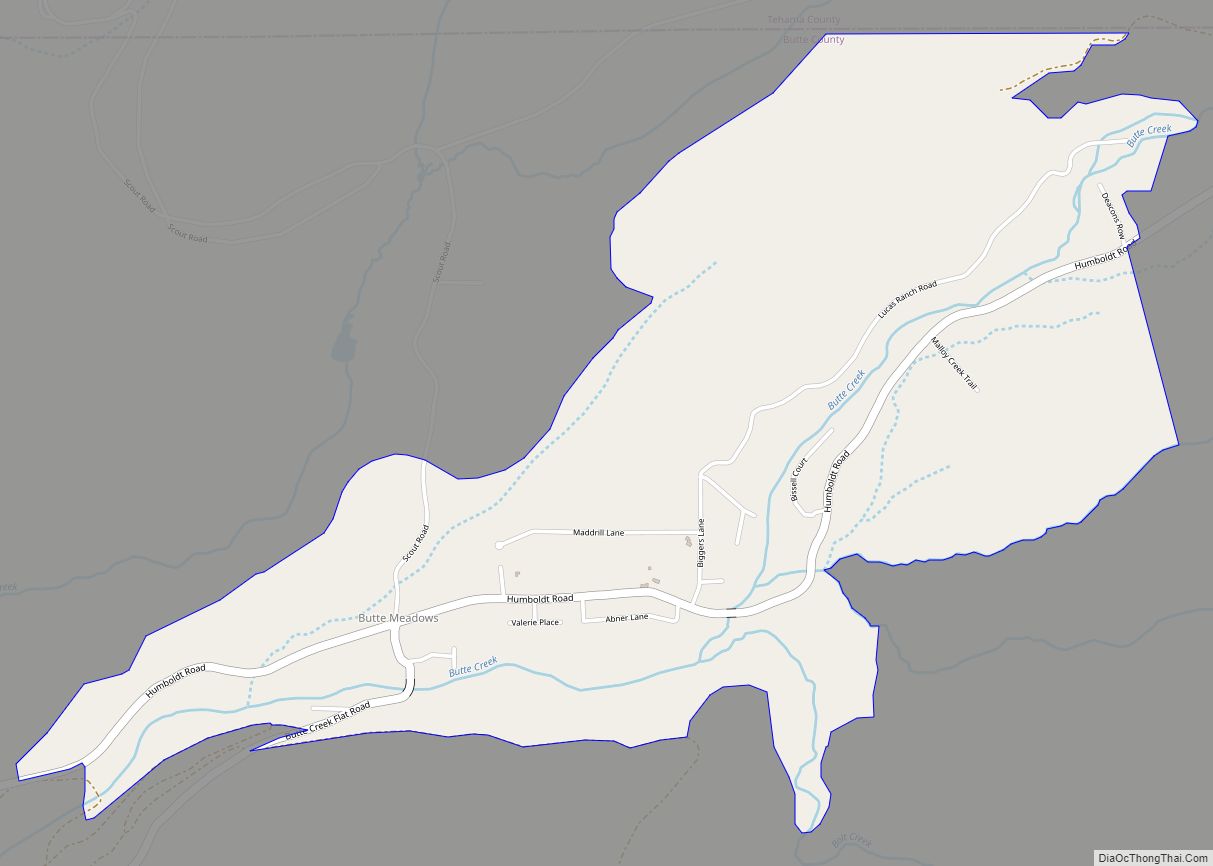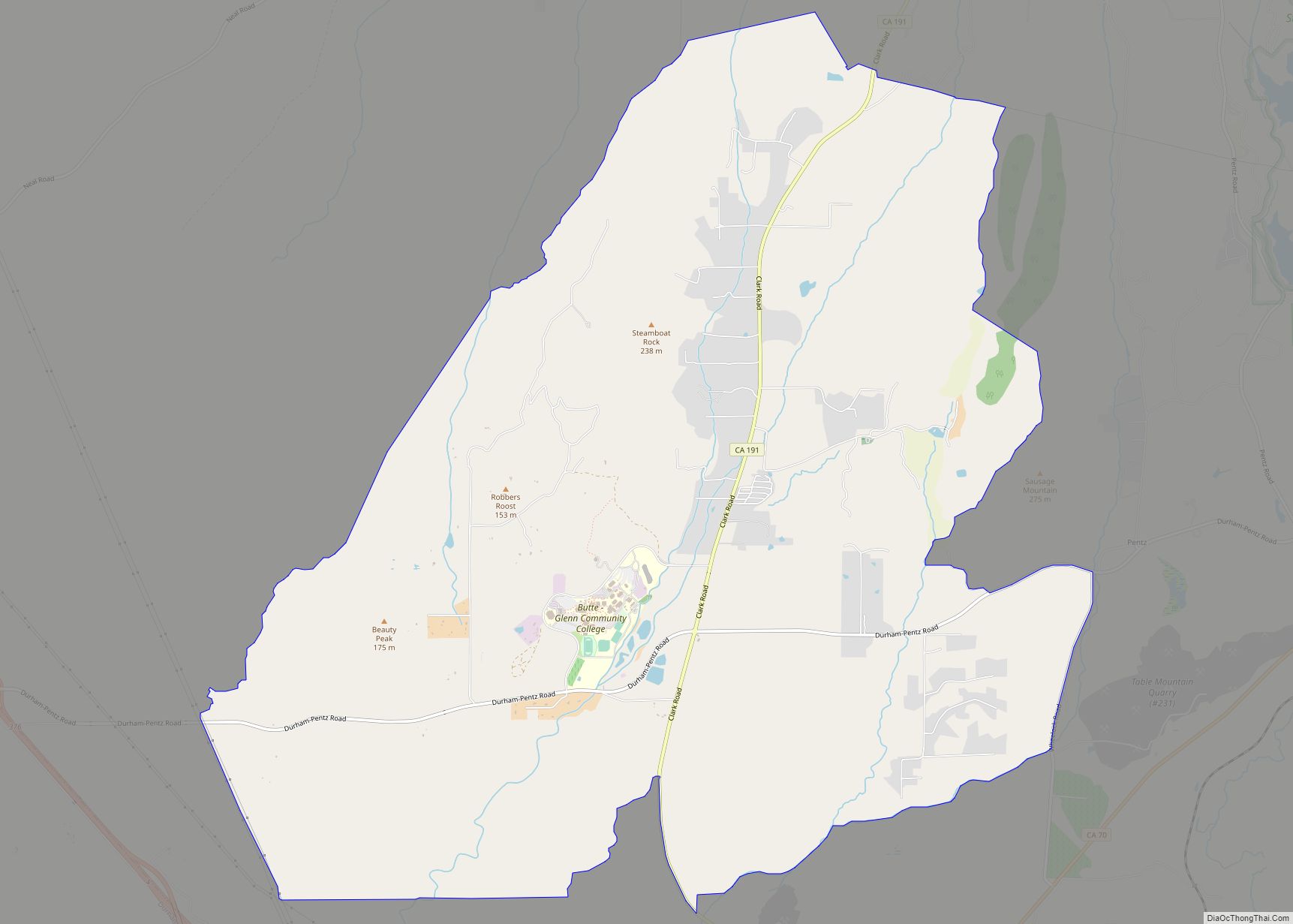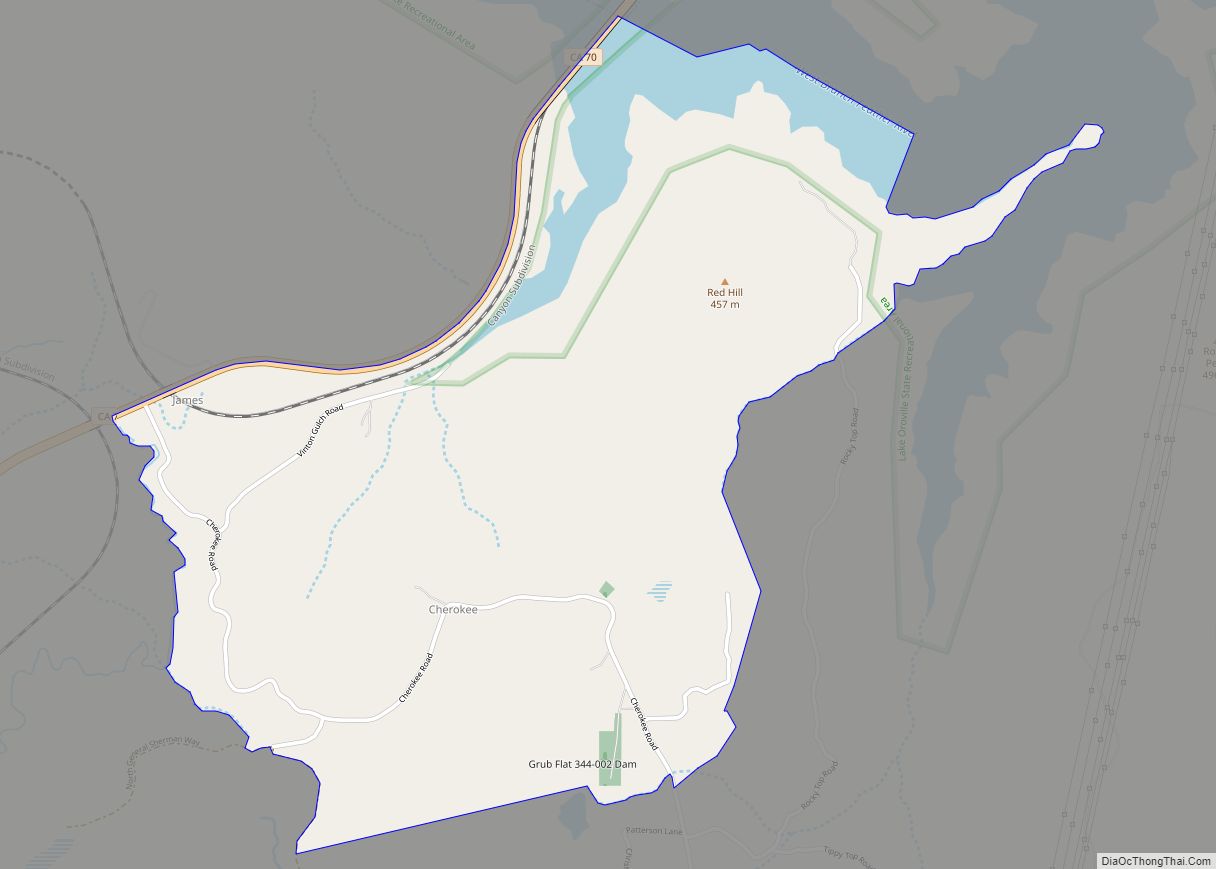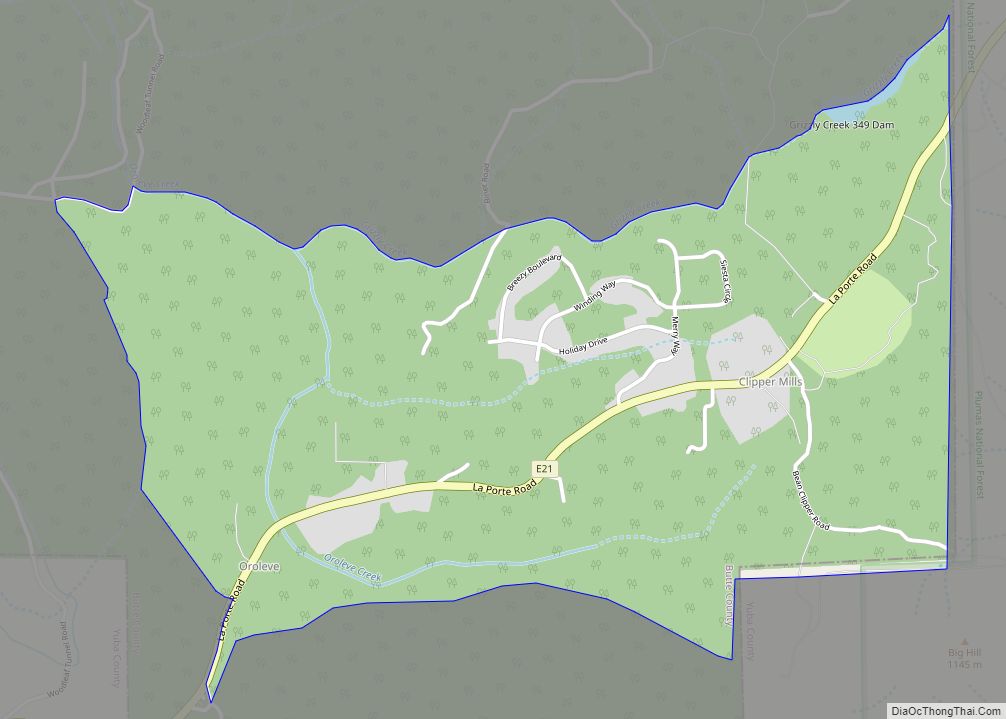Concow (Maidu: Koyoom Kʼawi, meaning “Meadow”) is an unincorporated community and census-designated place (CDP) in the Sierra Nevada foothills covering eastern Butte County, California. Due to a decline in employment and repeated wildfires, over the past hundred years the population declined from several thousand to several dozen. On November 8, 2018, a wildfire, the Camp Fire, destroyed most of Concow, as well as the adjacent municipality of Paradise.
Concow is named after the Native American tribe that is indigenous to the area, the Concow Maidu. The original inhabitants ate salmon from the Feather River, acorns and pine nuts, venison, nō-kōm-hē-i’-nē, and other sources of food which abounded in the California foothills.
| Name: | Concow CDP |
|---|---|
| LSAD Code: | 57 |
| LSAD Description: | CDP (suffix) |
| State: | California |
| County: | Butte County |
| Elevation: | 2,005 ft (611 m) |
| Total Area: | 27.78 sq mi (71.95 km²) |
| Land Area: | 27.41 sq mi (70.98 km²) |
| Water Area: | 0.37 sq mi (0.97 km²) 1.35% |
| Total Population: | 402 |
| Population Density: | 14.67/sq mi (5.66/km²) |
| ZIP code: | 95965 |
| Area code: | 530 |
| FIPS code: | 0616035 |
Online Interactive Map
Click on ![]() to view map in "full screen" mode.
to view map in "full screen" mode.
Concow location map. Where is Concow CDP?
History
“In the beginning Wahno-no-pem, the Great Spirit, made all things. Before he came, everything on the earth and in the skies was hidden in darkness and in gloom, but where he appeared he was the light. From his essence, out of his breath, he made the sun, the moon, and the countless stars, and pinned them in the blue vault of the heavens.”
Colonization
There is no indication that there was external governance of the Concow region or the tribal peoples that inhabited the region during the 1697–1821 Spanish colonization or the 1821–1846 Mexican era, characterized by the spread of Californio slave ranchos. The Concow region is 20 miles (30 km) north of the city of Oroville (an Anglo-Hispanic compound meaning ‘gold-town’) and about the same distance east of the town of Chico; named for Rancho Arroyo Chico—meaning ‘little creek ranch.’ Rancho Arroyo Chico was established through a land-grant from the Mexican authorities in 1844, two years before California was invaded by United States forces, an indication that there was some Mexican governance near the Concow region, but no indication of governance of the region.
Discovery
Aside from governance, starting in 1828, northern trappers including Jedediah Smith, Michel Laframboise, and John Work first made contact with the Concow region Maidu. In 1851 the Beckwourth Trail established the first transportation route to the Concow region. The route did not pass directly through the present day Concow, the trail followed a series of ridgetops 10 miles to the East.
Soon began death from diseases, such as pneumonia and malaria, from which the Maidu have no natural immunity.
Bounty and extermination
In 1853, under the leadership of Gov. Bigler, several municipalities within the State of California ordered all non-European people of California – including the Maidu – exterminated in return for a $5.00 ($134.95 in 2010 US$) cash bounty for each verified male killed and a lesser cash bounty for a dead woman or child. In addition to the municipal bounty system, through funding numerous militia attacks on the native people, the resulting debt became known as the “California War Debt” or “Army Appropriations Bill”.
In 1854 – though not entirely clear why – Secretary of War Jefferson Davis wrote California that their ‘war’ expenditures could not be authorized without the original bills of sale to verify the purpose was one intended by congress. The bill of sale for the bounty was the head. California was reimbursed $924,259.65 ($23.4M 2010US) by the United States Federal Government and again reimbursed $229,981.67 in 1861 for the intervening years. Sometimes children could be sold for more than the per claim amount allowed. To maximize profits, during ‘hunts’ they tried to only kill children that were not old enough to work. The older children were instead enslaved as provided by the Act of 1850 for the Government and Protection of Indians.
Assuming the $1.2M the State of California claimed in expenses for the ‘War’ was used entirely for $5 bounties, then this represents the death of 240,000 California natives; during that same time period the native population declined from 250,000 to less than 50,000, a comparable amount.
Settlement
Permanent settlements soon followed and by 1856 several were well established. The growth of these settlements increased after Charles Curtis constructed a toll bridge (1858) across the Feather River at Nelson’s Bar and the next year (1859) an additional bridge was constructed by residents of Whiskey Town over the Feather River just north of the Concow region. Basically, there was a Northernly trail and bridge from present day Oroville, and a Southernly trail and bridge from present day Magalia.
Removal of remaining Maidu
After a decade of genocide and forcible removals, in 1859 the last of the Kon Kow peoples were forcibly removed by Tehama County ranchers as part of a larger four county ’roundup’. They were held at the Mendocino Reservation until the California Reservation Administration at the camp collapsed due to lack of funding due to the Civil War occurring on the East Coast. The Kon Kow were then deported to the Nome Cult Farms at the Round Valley reservation.
By 1862, the last of the native Concow inhabitants were starving on the cramped Round Valley with unrelated people relocated from surrounding regions. The damp coastal climate on the reservation contrasts with the dry climate of the California “Gold Country” they are accustomed to. It was the midst of the North American Civil War, and federal funds for California Reservations were no longer arriving.
Some Maidu leave the reservation
In the cooling weather of late September, on September 24, 1862, a combination of the poor camp conditions, forced participation in a massacre of the local Wailaki peoples, warnings by local whites that they were planning to massacre the reservation inhabitants that winter, and an imminent winter disaster (under the supervision of indian agent James Short ) motivated a group of over 400 Maidu to leave the camp.
This group consisted of men, women, children, and elderly individuals. They set out with Tome-ya-nem, without provisions, for the 130 mile hike (210 km) back to their home in the Concow Valley. It was a 10-day hike for well equipped healthy young adults. They made it as far as present day Chico, where Agent Hanson had made an agreement with John Bidwell to stop and encamp the Kon Kow people at Bidwell’s old river landing (now under Lake Oroville). Under the supervision of Sub Agent Eddy, they were employed for $.10 per hour ($2.72 2013US) constructing the Chico-Humboldt road and providing labor for various employers in the area.
Massacre
The following spring three young children were attacked with the two boys killed and the kidnapped girl escaping after being forced to walk to a village near present-day Concow in what became known as the Pence massacre, the murders were within the present day Concow CDP and 9 miles (14.5 km) from Concow Valley – the KonKow people were blamed. These events happened amid documented incidents of local whites dressing as ‘indians’ and committing crimes and numerous mule-trains that were attacked and plundered by the various sierra peoples; indigenous, Spanish, and whites. All indications are that the children were kidnapped by a small group of native young men. In the following days 611 KonKow people were murdered by a vigilante volunteer posse of 500 white men that sought to kill every non-white in Butte County. M.H. Wells hid 50 Kon Kows in his Yankee Hill store in the foothills above the camp at Bidwell’s old river crossing; the vigilante group discovered these people. In a compromise the vigilantes inspected these people and determined four as ‘bad people,’ they were tied together in pairs and given a running start before the vigilantes opened fire, the rest were taken to the camp – two of the four were shot and killed. Under a resolution passed at a mass meeting of the public at Pence Ranch on July 27 a group of 12 led by Thomas McDonald of Cherokee and M.H. Wells of Yankee Hill found and convinced the remaining people in the surrounding area to go to the Bidwell camp for their own safety. A group of 26 led by G.G. Marquis of Concow, including Mr. Pence from Messilla Valley, B.P. Hutchinson from Cherokee Flat and John Chapman from Cherokee Ravine, gathered funds to cover the expenses for the Kon Kow people’s removal. Eventually 461 people including those who returned from Round Valley were gathered at Bidwell’s Landing. From this group, for the kidnapping and killing of the Lewis children, two were tied to a tree and executed by firing squad. The local US government representative Major George M. Hanson, Superintendent of Indian Affairs, Northern California, and the State Militia representative Captain Augustus W. Starr sent July 31 to assess the situation were unsure what to do with the popular movement or how to stop the acts of vigilante justice. The subsequent commanders of Camp Bidwell during the month of August, Captain Alfred Morton and then Major Ambrose E. Hooker – are absent in early correspondence from Captain Starr asking for guidance with the increasing number of Konkow ‘prisoners of war’.
The end
After consulting with Superintendent Hanson and superiors Colonel Richard Cloyd Drum and General George Wright, Captain Starr was ordered by General Wright in Post Order No. 6 to lead 23 soldiers of Company F 2nd Regiment California Volunteer Cavalry and move the now imprisoned people the 110 miles (180 km) from Camp Bidwell back to Round Valley on the Nome Cult Trail on what became a 20-day forced death march now remembered as the KonKow Trail of Tears. Despite efforts by the soldiers and the Pence resolution mandated donations of food and shelter provisions, horses and wagons, each day those who could not make the march through the hot arid early September Sacramento Valley – where afternoon temperatures top 90 °F (32 °C) or over the 6,000 foot (1,800 m) crest of the North Coast Ranges – were left behind without food or water and were soon killed by a pack of wild boar that formed behind and followed the group; the survivors were told to stay at the Round Valley concentration camp or be shot on sight. They were given no provisions by the soldiers and starved to death during the winter.
Bands of rogue natives
In 1864 a band of Kon Kow Maidu left the Round Valley reservation and again headed back to their home. The reservation agent sent a letter to the Concow post office noting their departure and that they seemed ‘hostile.’ What became of this band is not known, the following year in August a group of 25 Kon Kow were attacked and killed after a robbery that included two murders at the Robert Workman home; this became known as the Three Knolls Massacre and is seen as a smaller episode of the Mill Creek War. And the following year in February, another 5 Kon Kow were killed as continued retribution for the previous years murders.
Relics of Maidu
The current inhabitants of Concow, including a few Maidus, commonly find relics of the Maidu in the form of beads and stone tools while digging in and around their homes. There is no monument, plaque, or other recognition in Concow Valley to memorialize the fate of the KonKow people. Few if any of the current inhabitants are aware of the history.
Commune era
While a post office operated at Concow from 1882 to 1906, renamed from Con Cow to Concow in 1895, and relocated several times, the region was sparsely populated and dominated by a few ranching families. The economy of the region rose and fell with the gold rush need for supplies, the civil war demand for pine turpentine, logging, and the water way that allowed for ranching. The economy ebbed and flowed for a hundred years under the constraint of the difficult access to the region.
In 1962 a new four-lane alignment of California State Route 70 wrapped around the western side of the then proposed Lake Oroville and reconnected with the existing highway 70 at Jarbo Gap.
Wildfires
Beginning in 2000, a series of progressively larger fires burned through Concow.
A fire burned on September 19–20, 2000. The fire destroyed 14 structures. The first and smallest Concow fire of the 2000s, this fire was a 2,000 acre fire. At the time, it was considered a large fire.
In June 2008, as part of the Butte Lightning Complex Fires, a 60,000 acre (large fire) wildfire destroyed 250 structures. Of those structures, 220 were unpermitted and either were not built to building codes, did not bother with building inspections, or did not use approved building materials. Because of the back-to-the-land nature of the community, affording construction following building codes was not possible initially and reconstruction to building codes is not possible or within the ethos of the community. The county offered special waivers for reconstruction, but the community was already gutted. Those who remain are a shadow of the original community.
On September 26, 2012, at 3:10 PM, a wildfire burned 60 acres on Concow Rd at Jordan Hill Rd. CAL FIRE, El Medio Fire, Oroville Fire, USFS, and Butte Co. Fire Volunteers extinguished the fire. 120 total personnel were called to tend to the fire.
On November 8, 2018, a fire was reported at 6:33 a.m. PST, close to Camp Creek Road near Pulga. Shortly after the fire erupted, the Butte County Sheriff’s Office ordered evacuations of surrounding communities and switched to life saving operations. On the first day, much of the town of Paradise and community of Concow were destroyed. As of December 13, Butte County Sheriff’s Department reported that at least 6 people died in Concow during the Camp fire. A fallen tree blocked the primary evacuation route from the town and some residents survived by jumping into the creek.
Concow Road Map
Concow city Satellite Map
Geography
According to the United States Census Bureau, the CDP has a total area of 28 square miles (73 km), of which, 27 square miles (70 km) of it is land and 0.4 square miles (1.0 km) of it (1.4%) is water.
For unknown reasons the community’s name was absent from the US Geological Survey files until 1990. Other nearby communities are The Pines (USGS feature ID 268203), and Deadwood (USGS feature ID 1655957).
The community is located off State Route 70 north of Cherokee. The infrastructure is minimal. There is Concow Elementary School, Concow Dam and Reservoir, and the primary paved access route – Concow Road.
See also
Map of California State and its subdivision:- Alameda
- Alpine
- Amador
- Butte
- Calaveras
- Colusa
- Contra Costa
- Del Norte
- El Dorado
- Fresno
- Glenn
- Humboldt
- Imperial
- Inyo
- Kern
- Kings
- Lake
- Lassen
- Los Angeles
- Madera
- Marin
- Mariposa
- Mendocino
- Merced
- Modoc
- Mono
- Monterey
- Napa
- Nevada
- Orange
- Placer
- Plumas
- Riverside
- Sacramento
- San Benito
- San Bernardino
- San Diego
- San Francisco
- San Joaquin
- San Luis Obispo
- San Mateo
- Santa Barbara
- Santa Clara
- Santa Cruz
- Shasta
- Sierra
- Siskiyou
- Solano
- Sonoma
- Stanislaus
- Sutter
- Tehama
- Trinity
- Tulare
- Tuolumne
- Ventura
- Yolo
- Yuba
- Alabama
- Alaska
- Arizona
- Arkansas
- California
- Colorado
- Connecticut
- Delaware
- District of Columbia
- Florida
- Georgia
- Hawaii
- Idaho
- Illinois
- Indiana
- Iowa
- Kansas
- Kentucky
- Louisiana
- Maine
- Maryland
- Massachusetts
- Michigan
- Minnesota
- Mississippi
- Missouri
- Montana
- Nebraska
- Nevada
- New Hampshire
- New Jersey
- New Mexico
- New York
- North Carolina
- North Dakota
- Ohio
- Oklahoma
- Oregon
- Pennsylvania
- Rhode Island
- South Carolina
- South Dakota
- Tennessee
- Texas
- Utah
- Vermont
- Virginia
- Washington
- West Virginia
- Wisconsin
- Wyoming
